What Is Baking Powder and How Does It Work
Chemical leavening agents like baking soda and baking powder can have a profound effect on your favorite baked goods. What is baking soda vs. baking powder? How do they actually work? What are the differences between them?
Those are the questions I'll be answering for you today, and guess what… I brought VISUALS! Let's dive in!
Baking Soda vs. Baking Powder
What are chemical leaveners? Can you substitute baking powder for baking soda and vice versa?
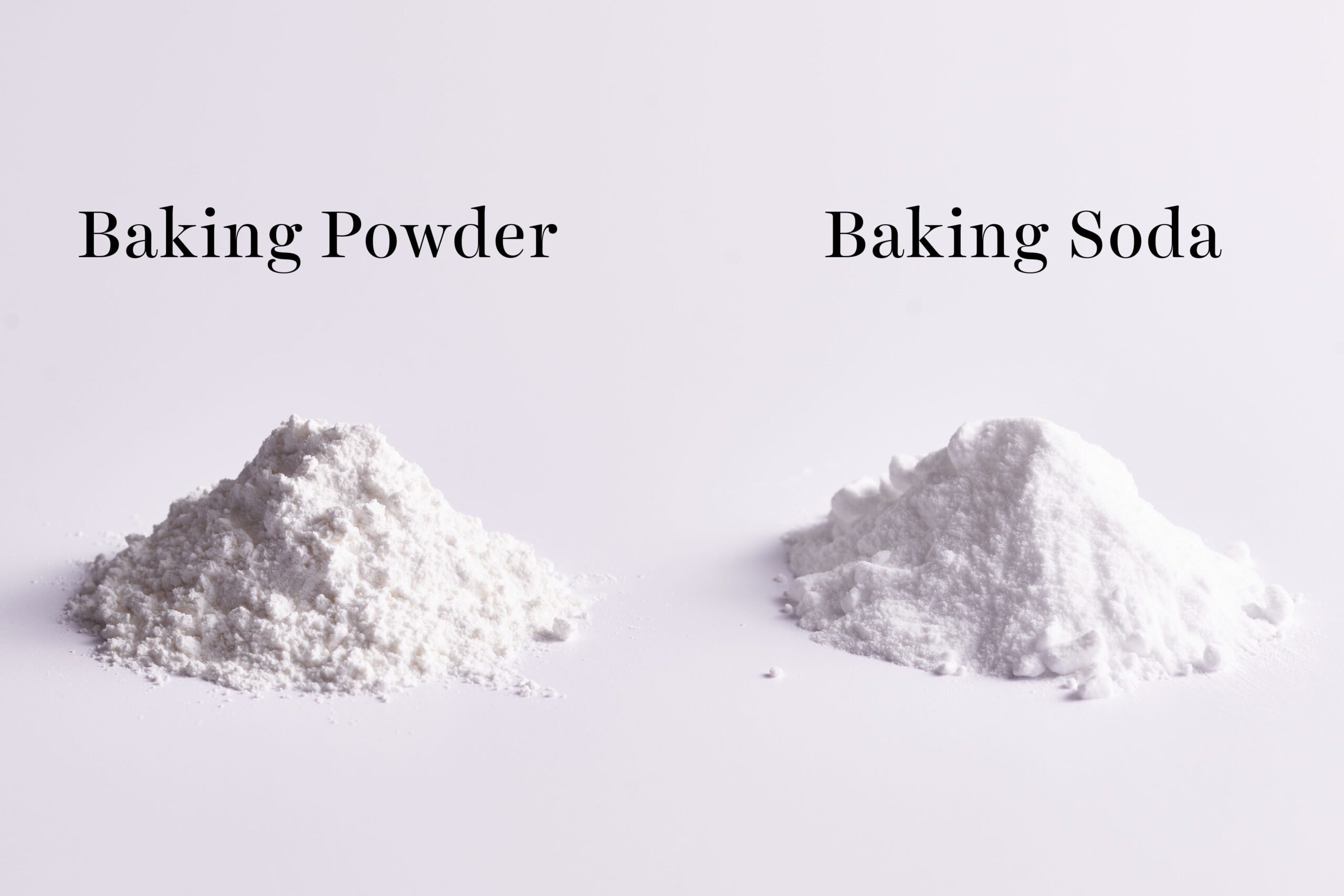
Baking powder and baking soda are both chemical leaveners that work to create light textures in baked goods—but only under the correct conditions. They release gases, primarily carbon dioxide, through chemical reactions between acids and bases.
Although baking powder actually contains baking soda, the two leaveners are very different. Baking powder and baking soda are not interchangeable, however, they both provide three similar main functions:
- Leavening: Baking powder and soda release gases that form bubbles which expand within the batter or dough during the baking process. The protein in the batter or dough then sets around those air pockets. This creates rise and lift in the structure of your baked goods.
- Tenderizing: As the gases form and expand, cell walls in baked goods begin to stretch and thin. This results in a more tender texture that's easier to eat.
- Provide flavor: Small amounts of chemical leaveners can contribute a salty, sour flavor that is distinct to baked goods like biscuits, scones, or Irish soda bread.
Why it's SO important to use a leavener in most recipes!
Take a look at the image below to see what happens when NO chemical leavener is used in my Ultimate Muffin Recipe compared to using both baking powder and baking soda:
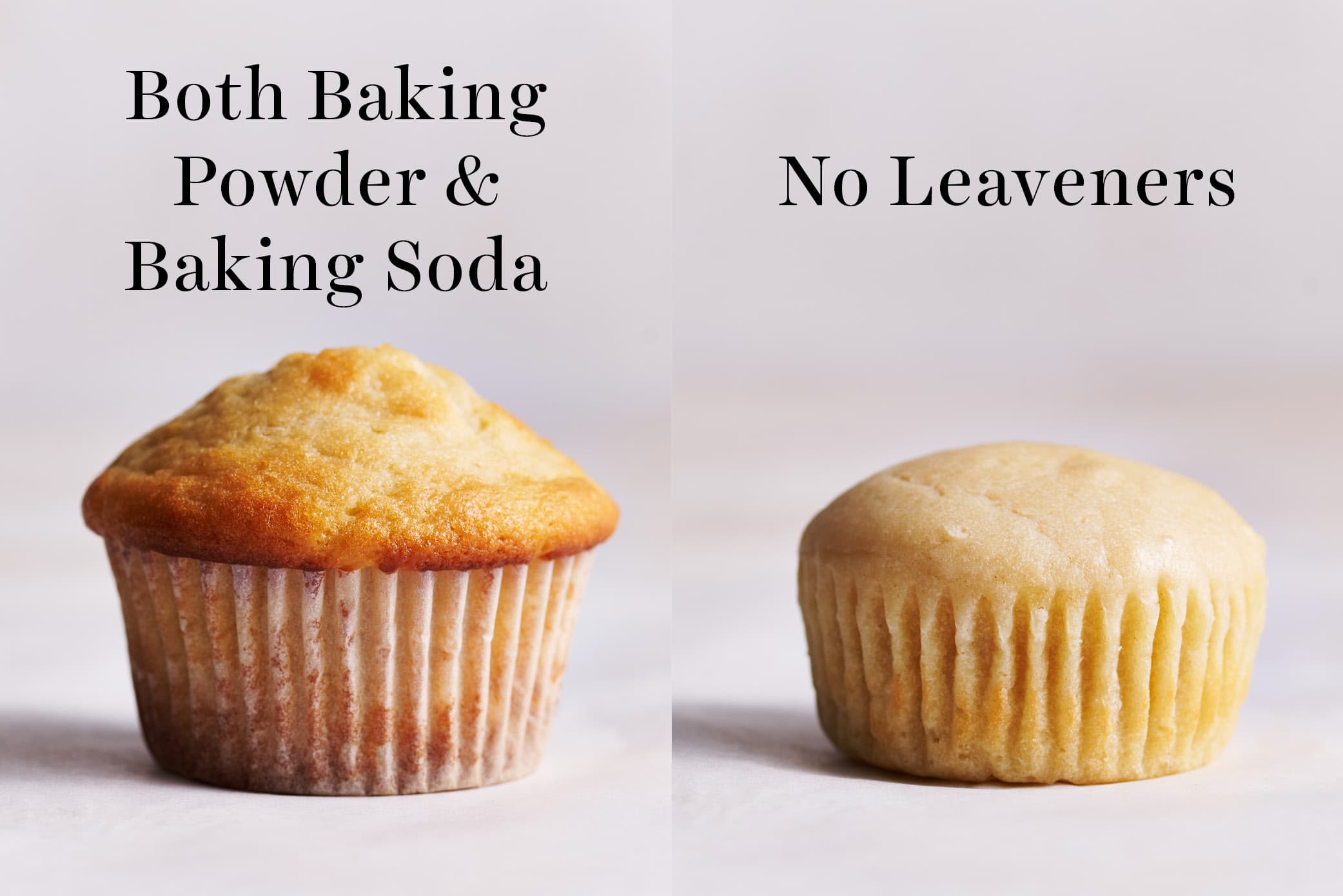
The muffins without any leavener are extremely dense and almost taste unbaked despite being baked for the exact same amount of time as the other!
Why do some recipes not call for baking powder or baking soda?
The recipes where you don't need a chemical leavener are the ones that use yeast, which is an organic leavener that also works by producing gas bubbles, or recipes that whip lots of air into the batter or are custard-based (like ice cream or crème brûlée), where rich creaminess is the desired texture.
What is baking soda and how does it work?
Baking soda, referred to scientifically as sodium bicarbonate, is a natural pure alkaline substance activated by moisture and acid present in the batter, dough, or mixture to produce gas.
Naturally acidic ingredients that will active baking soda:
- Buttermilk
- Sour cream
- Yogurt
- Lemon juice
- Honey
- Natural cocoa powder (NOT Dutch-processed)
- Unsweetened chocolate
- Brown sugar
- Molasses
- Fruits & fruit juices
There must be some acidic ingredient in the recipe for baking soda to function. Baking soda begins to leaven as soon as it touches liquid present in the dough or batter. So if you wait too long before baking, you may notice a decrease in leavening effect (especially in wetter dough or batters).
In professional baking, this is referred to as 'bench tolerance,' or how long a batter or dough can be stored before it has lost its leavening. For recipes that rely mostly on baking soda for their structure which are also full of moisture, such as certain cake batters, they shouldn't be stored too long before baking.
How baking soda changes baked goods:
If you use too much baking soda, you may taste an unpleasant metallic, soapy, or bitter flavor in your food. This can happen by accident by mis-measuring or when making other changes to an established recipe.
Baking Soda Elevates pH
Baking soda helps add a beautiful browned color to baked goods by elevating pH levels. Baking soda is also present in baking powder but in a smaller amount so it has a lower pH level which results in less browning.
A higher pH in baked goods can affect color, flavor, texture, and gluten development! For example, baking soda in brownies or gingerbread enhances the deep dark color and smoothes out the chocolate flavor.
Meanwhile, baking soda in cookies leads to more spread and a crispy edge compared to baking powder:
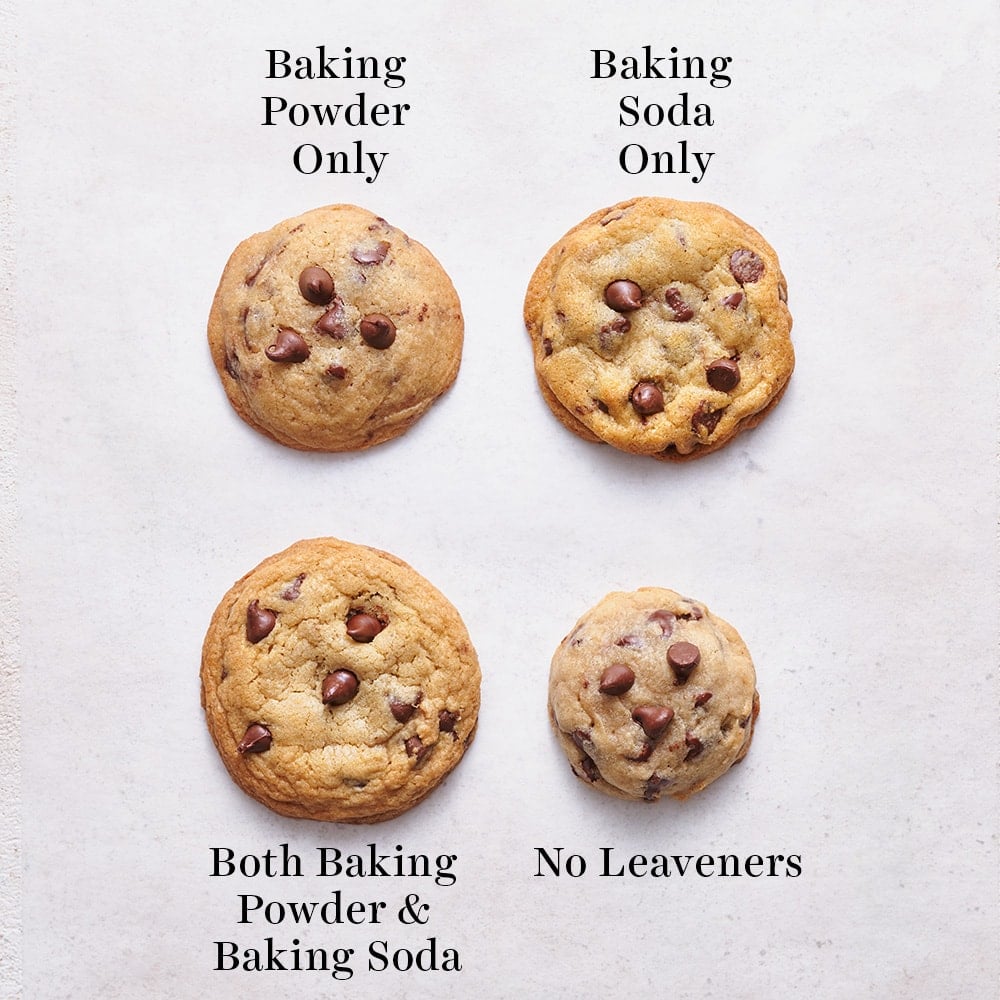
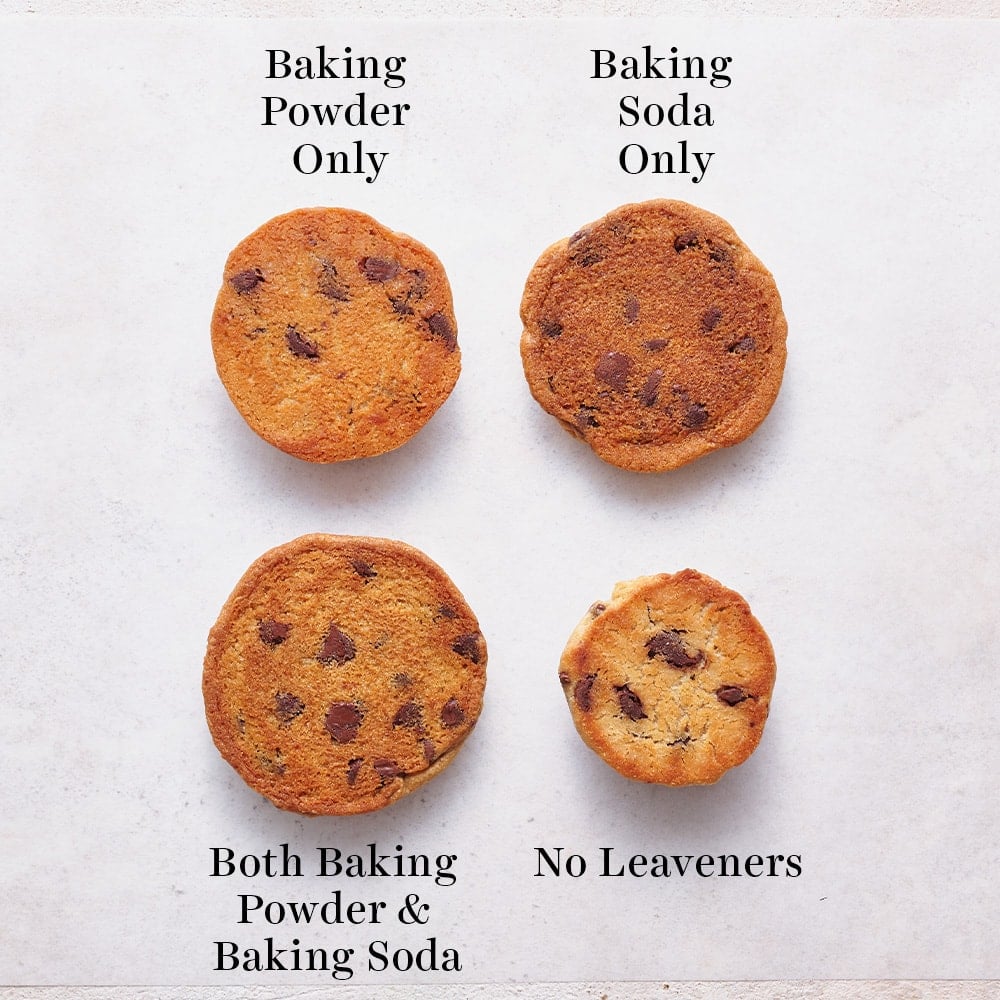
Since baking soda must be fresh to work properly, it's important to switch out your container before the expiration date. However, baking soda can lose its effectiveness even before that date.
How to test baking soda for freshness:
Place 1/4 teaspoon baking soda in a bowl and pour 1 teaspoon of distilled vinegar on top. If the baking soda immediately bubbles violently, it is fresh. If nothing happens, throw away the baking soda and buy a new package.
What is baking powder and how does it work?
Baking powder is a combination of baking soda, an acid (usually cream of tartar), and an anti-caking agent such as cornstarch. Because it contains both the acid and the base necessary for the desired chemical reaction, your batter or dough doesn't require additional acidic ingredients to work properly. Just moisture and heat! This makes baking powder a complete leavening system.
Most baking powder available in the U.S. today is double acting, meaning its first reaction occurs when combined with liquid to help aerate the batter or dough, and a second more slow-acting reaction occurs when heated in the oven. This means that baking powder dough or batters have a better bench tolerance and can be stored and baked at a later time. If using aluminum-free baking powder, I recommend looking for one that is also marked as double acting for best results.
How baking powder changes baked goods:
The small amount of cream of tartar in baking powder decreases pH and weakens gluten. In recipes like muffins, biscuits, and cakes, many of which rely entirely on baking powder, this results in a tighter, whiter, and delicate texture:
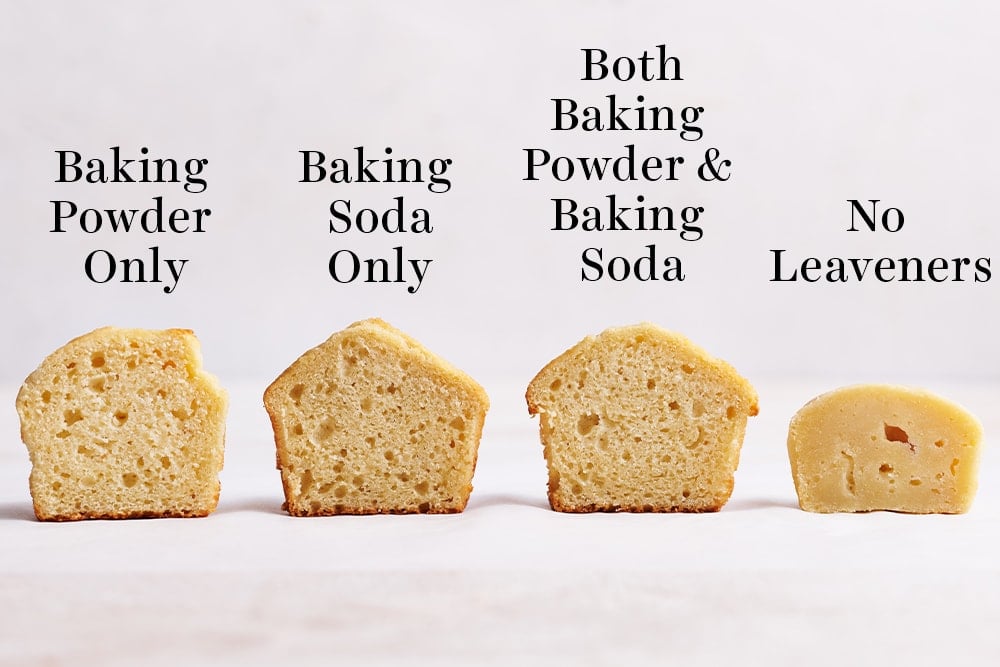
Strength
It's important to understand that baking soda is four times stronger than baking powder. This means 1 teaspoon of baking powder will raise a cup of flour, whereas only a 1/4 teaspoon of baking soda can produce the same effect. A general rule of thumb is that ½ teaspoon of baking soda is neutralized by 1 teaspoon of lemon juice or vinegar.
How to test baking powder for freshness:
Place 1 teaspoon of baking powder in a bowl with 1 cup of hot water from the tap. If it bubbles up, the baking powder is fresh. If nothing happens, throw the baking powder away and buy a new container.
How to store baking powder and baking soda:
Purchase in the smallest size feasible based on how often you bake and use chemical leavening agents. Store in a cool place in an airtight container. Air and light can cause them to lose their effectiveness before their expiration date, which is why I included freshness tests above!
Which is better: baking powder or baking soda?
Neither one is better than the other, they are simply used depending on the chemistry of the recipe, how it will be handled, and what the desired outcome is!
Take a look at some of the experiments we did with baking powder and baking soda.
Below you'll see the same exact base muffin recipe baked in the same trays at the same temperature for the same amount of time. The only difference is the chemical leavening agent used!
Baking powder muffins: these were tall, light, slightly delicate, fluffy, and cakey. They were evenly domed on top. These were my favorite, followed by batch 3 which had both!
Baking soda muffins: these were slightly more browned, they had very tall peaks in the center, and they had an ever so slightly sour taste. Almost like there was sour cream in the batter (there wasn't).
Both baking soda and powder muffins: These muffins were the most browned and caramelized and had a more springy texture.
No leavener muffins: These were leaden, dense, rubbery, and really just a doughy, inedible mess.
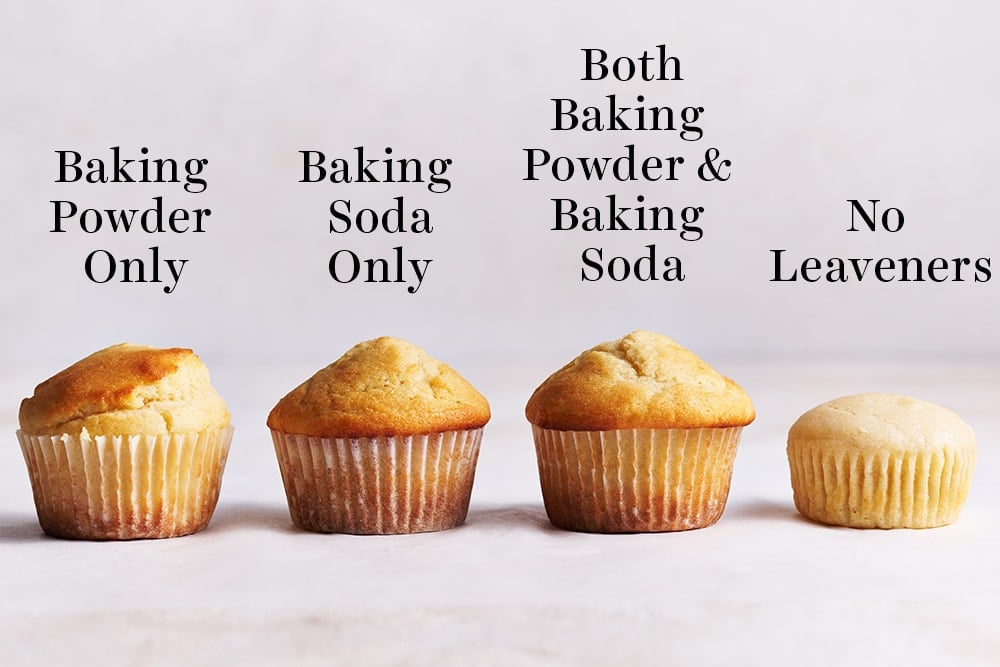
We repeated the same experiment with my Bakery Style Chocolate Chip Cookie Recipe:
Baking powder cookies: These were extra thick and tall, not chewy, more fluffy, and not quite as flavorful.
Baking soda cookies: These cookies were well browned with slightly crispy edges, chewy interiors, and regular thickness. They didn't stale as quickly so they were more shelf stable. They were my favorite!
No leavener cookies: These were dense, heavy, and had a similar texture to "Mexican Wedding Cookies."
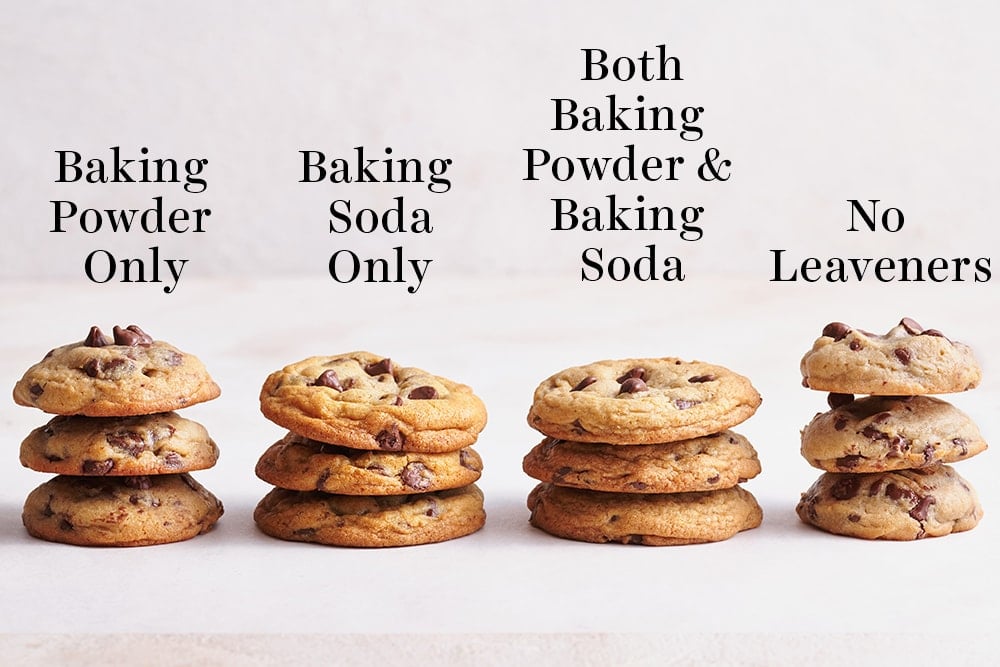
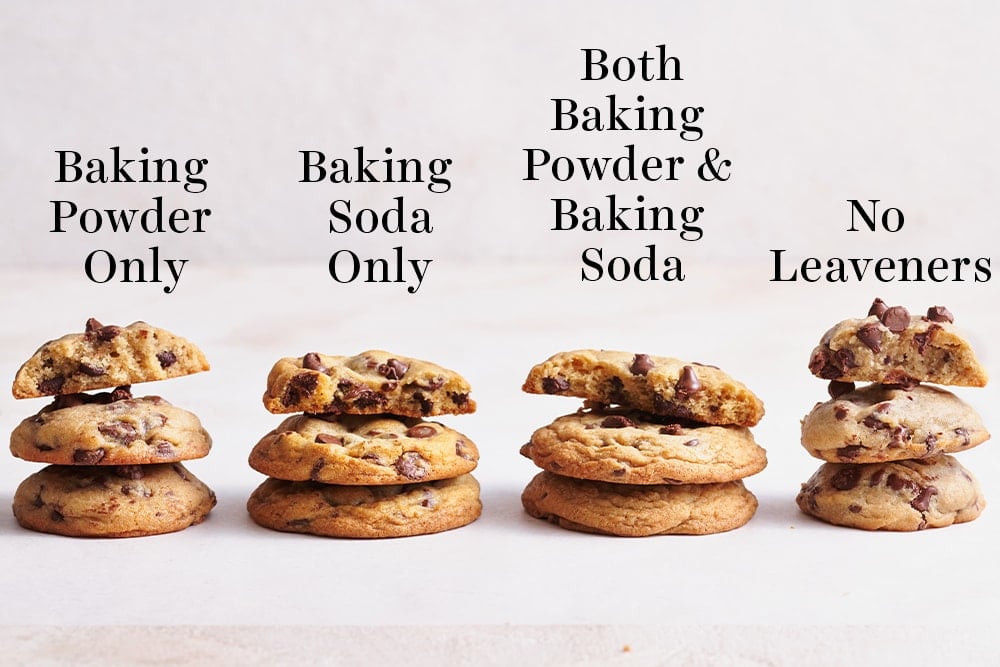
Why do some recipes call for both baking soda and baking powder?
As you can see above, sometimes we want the best of both worlds! Some recipes call for both baking soda and baking powder in order to have the highest effect of acid-neutralizing and leavening powers.
This works especially well for an acidic dough that needs to be stored overnight, such as my favorite Ultimate Chewy Chocolate Chip Cookie recipe.
Photos by Joanie Simon | The Bite Shot.
What Is Baking Powder and How Does It Work
Source: https://handletheheat.com/baking-soda-vs-baking-powder/
0 Response to "What Is Baking Powder and How Does It Work"
Post a Comment